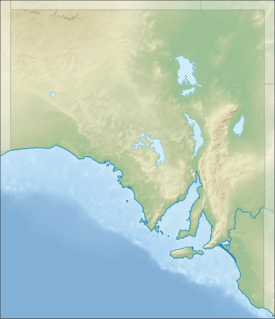Mount Remarkable National Park
| Mount Remarkable National Park South Australia | |
|---|---|
|
IUCN category VI (protected area with sustainable use of natural resources) | |
 Mount Remarkable National Park | |
| Nearest town or city |
Melrose Port Germein Port Pirie |
| Coordinates | 32°46′53″S 138°03′46″E / 32.78139°S 138.06278°ECoordinates: 32°46′53″S 138°03′46″E / 32.78139°S 138.06278°E |
| Established | 1 January 1952[1] |
| Area | 182.71 km2 (70.5 sq mi)[1] |
| Visitation | 50,000 (in 2006)[2] |
| Managing authorities | Department of Environment, Water and Natural Resources |
| Website | Mount Remarkable National Park |
| Footnotes | nearest towns and cities[3] |
| See also | Protected areas of South Australia |
Mount Remarkable National Park is a protected area in the Australian state of South Australia located about 238 kilometres (148 mi) north of the state capital of Adelaide and 25 kilometres (16 mi) east of Port Augusta. It is also the name of the highest peak in the park, with a height of 960 metres (3,150 ft).
Description
The national park consists of three separate areas.[3]
The first is the parcel of land (also known as a block in some sources) located immediately west of the town of Melrose and consists of the following three areas - the Warren Bonython Link, Mambray Creek and Mount Remarkable. As of 2006, this parcel of land occupied an area of 165.83 square kilometres (64.03 sq mi).[3]
The second is a parcel of land known as the Telowie block which has an area of 0.35 square kilometres (0.14 sq mi) as of 2006, and is located on the west side of the Telowie Gorge Conservation Park about 7.5 kilometres (4.7 mi) east of the town of Port Germein and about 24 kilometres (15 mi) south of the block located at Melrose.[3]
The third is a parcel of land known as the Napperby Block with an area of 16.72 square kilometres (6.46 sq mi) as of 2006 and which is located immediately east of the town of Napperby, about 4 kilometres (2.5 mi) south of the Telowie Gorge Conservation Park and about 12 kilometres (7.5 mi) north-east of the city of Port Pirie.[3]
The national park is classified as an IUCN Category VI protected area.[4]
History
Land associated with the national park at Mambray Creek and Alligator Gorge first obtained protected area status in 1952 as national pleasure resorts declared under the National Pleasure Resorts Act 1914 which were managed by the South Australian Government Tourist Bureau for the period from 1952 to 1967.[5]
In 1964, the National Parks Commission submitted a proposal to the Government of South Australia for "comprehensive national parks "covering an area larger than that of the existing national pleasure resorts. This resulted in the creation of three separate reserves - the Alligator Gorge Wildlife Reserve, the Mambray Creek Wildlife Reserve and the Mount Remarkable Wildlife Reserve that were respectively constituted in July 1965, September 1967 and March 1966.[5]
In 1972, the three wildlife reserves were re-proclaimed under the National Parks and Wildlife Act 1972 as the Mount Remarkable National Park. Since 1972, the national park is reported as doubling in size from an area of 8,236 hectares (20,350 acres) by the addition of land including the Black Range Lookout and the Bluff in 1976 and by the addition of an "area west of Alligator Gorge containing The Battery", two parts of the Willowie Forest Reserve and the Napperby Block in 1993.[5]
In 2000, land which was subsequently renamed as "The Warren Bonython Link" in honour of Warren Bonython’s "long personal interest in the area" and "his association with the National Parks Foundation" was added to the national park.[6] As of 2014, the national park had an area of 18,271 hectares (45,150 acres).[1]
See also
- Protected areas of South Australia
- Alligator Gorge
Citations and references
Citations
References
- "Terrestrial Protected Areas by Reserve Type in South Australia (2014)". CAPAD 2014. Australian Government - Department of the Environment (DoE). 6 February 2014. Retrieved 6 February 2014.
- "Mount Remarkable National Park Management Plan" (PDF). Department for Environment and Heritage (DEH). 2006. Retrieved 3 September 2015.
- "Mount Remarkable National Park Management Plan Amendment 2013" (PDF). Department for Environment Water and Natural Resources (DEWNR). 2013. Retrieved 3 September 2015.
- "Protected Areas Information System - reserve list (as of 16 July 2015)" (PDF). Department of Environment Water and Natural Resources (DEWNR). 2015. Retrieved 3 August 2015.
External links
- Mount Remarkable National Park official webpage
- Friends of Mount Remarkable National Park official website
- Mount Remarkable National Park webpage on protected planet

